Picture this: golden sunsets casting long shadows over centuries-old stone walls, the echoing whispers of bygone battles, the feeling of standing in the very footprints of history.
Welcome to Florida’s historic forts! These jewels of the past make the Sunshine State not only a paradise for beach-goers but also a treasure trove for history buffs. This post will dive into the captivating world of the most famous Florida forts and their intriguing stories.
Why Visit Florida’s Historic Forts?
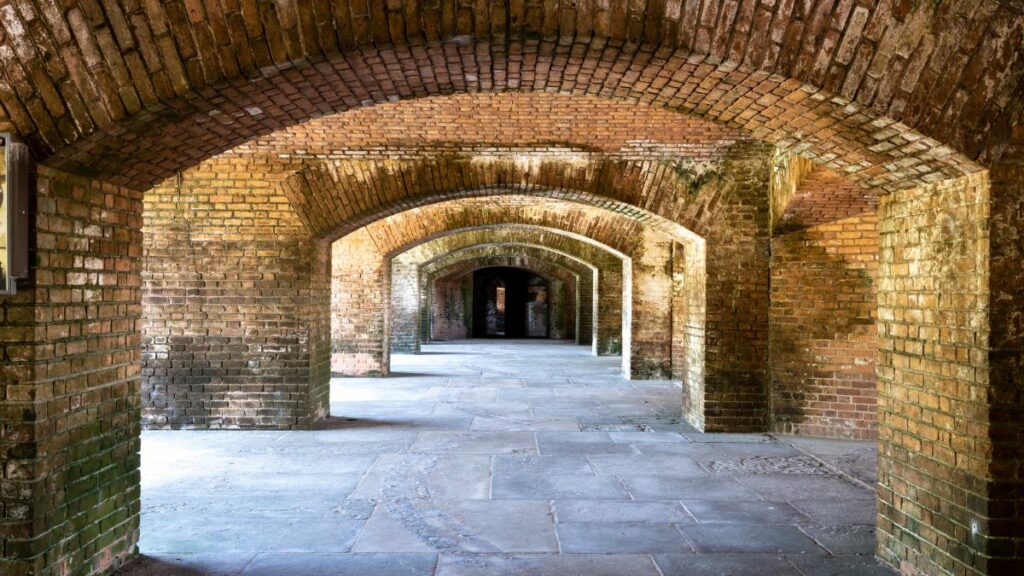
Florida is not just about sandy beaches, Disneyland, or the famed Everglades. The state boasts a rich history, part of which can be experienced in the grandeur of its many historic forts. These structures reflect a varied past marked by conflicts, colonization, and cultural intermingling.
The Castillo de San Marcos in St. Augustine is a perfect example. Built by the Spanish in the late 17th century, it is the oldest masonry fort in the continental United States. The fort, designed in a star shape, was constructed using coquina, a unique limestone composed of shell fragments that makes it impressively resistant to cannon fire.
With its complex system of moats, drawbridges, and massive bastions, the fort reflects the advanced military architectural techniques of the time. Furthermore, it tells stories of multiple sieges, changes in rule from Spanish to British and back, and finally, its acquisition by the United States.
Further off the mainland, located approximately 70 miles west of Key West in the Gulf of Mexico, is the imposing structure of Fort Jefferson. It is part of the Dry Tortugas National Park, known for its clear blue waters, coral reefs, and abundant sea life. The fort was built in the 19th century as part of America’s coastal defense system.
Constructed using over 16 million bricks, it is one of the largest brick masonry structures in the Americas. Despite its remote location, the fort has seen use as a military prison and was even a coaling station for U.S. Navy ships. It now stands as a monument of American history, a quiet sentinel watching over the waters.
Both these forts, among others in Florida, offer us a unique chance to dive deep into the state’s past. They encapsulate the Spanish, British, and American influences that have shaped Florida’s history. Whether it’s the imposing walls of the Castillo de San Marcos overlooking the Matanzas River or the massive expanse of Fort Jefferson amid oceanic blues, these forts offer a journey back in time, wrapped in scenic beauty.
These forts are also windows into the bygone eras’ engineering marvels and architectural brilliance. They are symbols of military strength and reflect the transformation that the region underwent – the shift from native lands, through periods of European colonization, to becoming a part of the United States.
The narratives of these forts interweave tales of conquest, resilience, and transformation, thereby underlining their significant role in shaping American history. While exploring these forts, visitors can absorb the multilayered complexities of Florida’s past, which is crucial for understanding the state’s present and future. Therefore, each visit promises an adventure and offers a profound historical understanding of this vibrant region.
A Snapshot of Florida’s Fort History
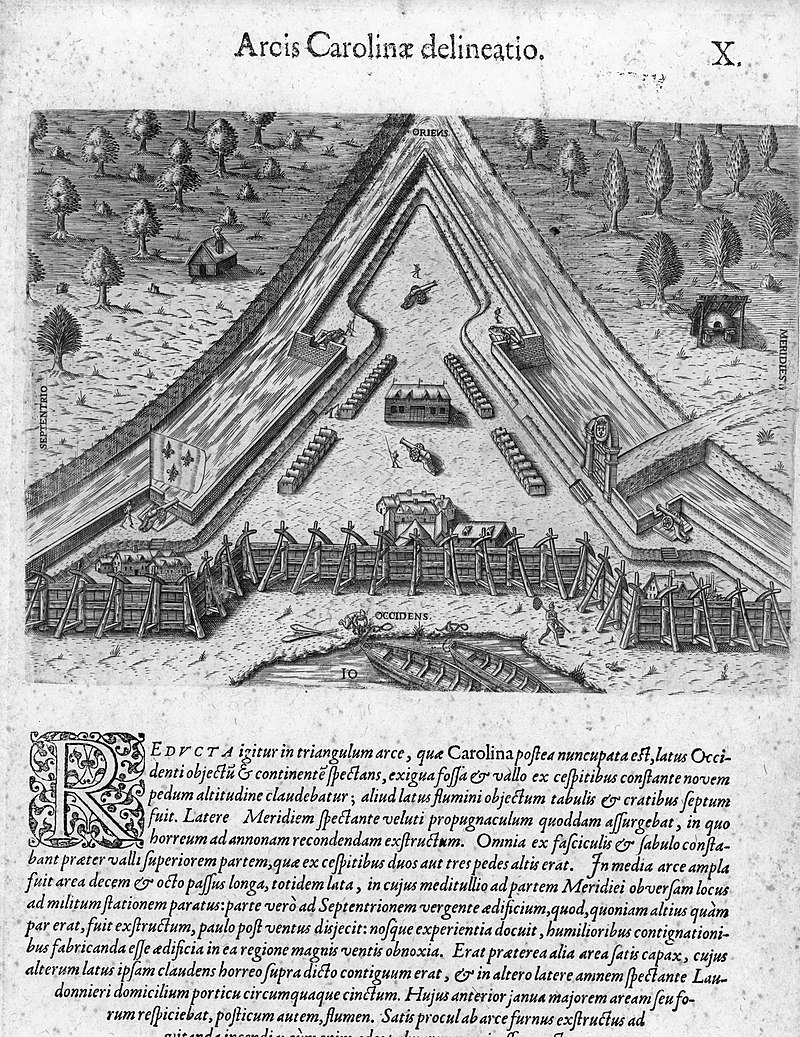
The tale of Florida’s forts is steeped in the vibrant historical tapestry of the region, encompassing many eras of exploration, conquest, and conflict. Fort Caroline was established by the French explorer Jean Ribault in the mid-16th century, marking the first permanent European settlement in Florida. However, the fort’s history was short-lived, as Spanish forces from the nearby colony of St. Augustine seized it within a year.
Next came the oldest masonry fort, the Castillo de San Marcos (later renamed Fort Marion), built by the Spanish during the late 17th century. This architectural marvel, made with coquina, a limestone composed of shell fragments, played a vital role in safeguarding Spanish interests in the New World.
Its strategic location in St. Augustine allowed Spain to control the Atlantic seaboard and protect their treasure fleets returning to Spain, thus serving as a cornerstone of Spanish colonial power.
The tumultuous period of the Seminole Wars in the 19th century brought a new significance to the forts of Florida. The Second Seminole War saw General Winfield Scott, a future president, utilize forts like Fort Clinch on Amelia Island. These forts served as crucial military posts and supply depots, acting as the backbone of operations against the Seminoles, who were resisting forced relocation to Indian Territory.
The Civil War era added another layer of complexity to the history of these forts. Fort Pickens on Pensacola Bay and Fort Zachary Taylor in Key West became centers of conflict, their control signifying power over strategic locations.
Fort Pickens was among the few Southern forts to remain under Union control throughout the Civil War, a testament to its strength and strategic importance. Fort Zachary Taylor, also under Union control, was pivotal in the naval blockade that restricted Confederate shipping.
Finally, during the Spanish-American War at the end of the 19th century, many of these forts were revitalized for the conflict. They provided logistic support, serving as staging areas for U.S. forces bound for Cuba.
The history of Florida’s forts is not just about the physical structures but also the pivotal roles they played in various conflicts and their enduring impact on shaping the region’s history. Each fort has a story – tales of European power struggles, Native American resistance, national conflicts, and more, all contributing to the rich historical tapestry that makes Florida unique.
Top 5 Must-Visit Historic Forts in Florida
1. Castillo de San Marcos
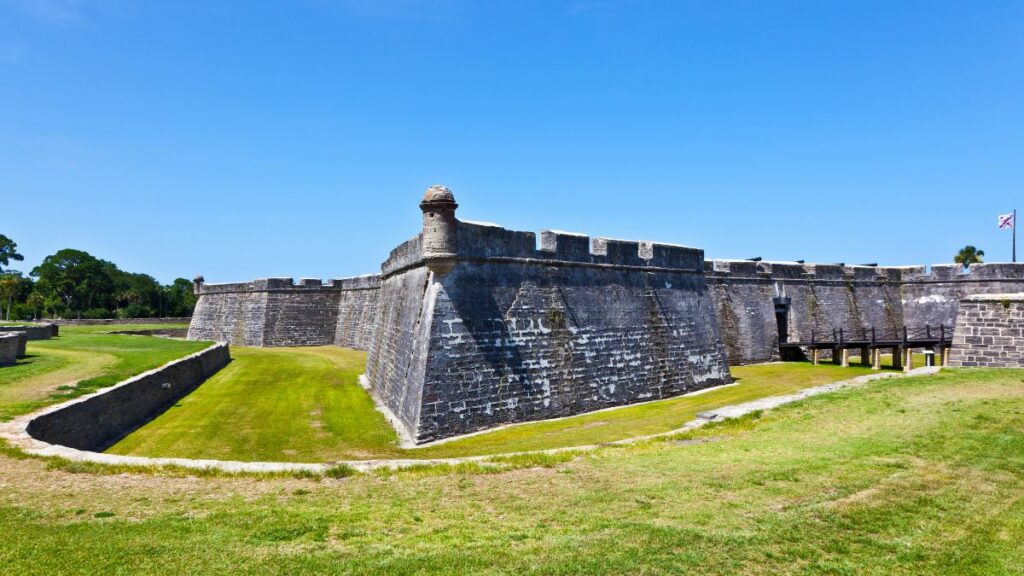
Castillo de San Marcos, standing tall in St. Augustine and overlooking the picturesque Matanzas Bay, is a remarkable symbol of the tumultuous history of Florida. Built-in the late 17th century by the Spanish Empire to defend its claims in the New World, it is the oldest masonry fort in the continental United States.
The structure was made from coquina, a locally sourced limestone composed of shell fragments, a material choice that gave the fort impressive resilience against enemy cannon fire.
Constructed in a distinctive star shape, the fort’s design exemplifies the bastion system of fortification, an evolution in military architecture during the era. This design, combined with its strategic coastal location, made it an imposing and formidable stronghold that protected Spanish interests in the region.
Once known as Fort Marion, the Castillo de San Marcos played a significant role in the Seminole Wars, a series of conflicts in the 19th century between various groups of Native Americans known as Seminoles and the United States.
It functioned as a strategic base for military operations and, later, a prison for captured Seminole warriors. This era marked a significant shift in the fort’s use, bringing attention to its capacity as a place of confinement.
During the Second Seminole War (1835-1842), the fort served as a military prison for Seminole prisoners, including the famous war leader, Osceola. Following his capture under a flag of truce, Osceola was imprisoned in the fort along with other leaders. Their incarceration attracted national attention, bringing the Castillo de San Marcos into the limelight.
After The Seminole Wars
Beyond the Seminole Wars, the fort served as a military prison. During the Spanish-American War in the late 19th century, it held court-martialed deserters. Later, it was used to incarcerate Native American prisoners from western tribes, and during the early 20th century, it even held a few conscientious objectors to World War I.
Presently, the Castillo de San Marcos is a National Monument under the stewardship of the National Park Service. Visitors can tour the fort, explore its casements, and walk its bastions while learning about its captivating history.
From its ancient coquina walls to the sweeping views of Matanzas Bay, the fort stands as a testament to Florida’s complex past, encapsulating over 345 years of history and resilience. It serves as a living monument, narrating the stories of Spanish colonization, Native American resistance, and the transformation of a nation.
2. Fort Jefferson
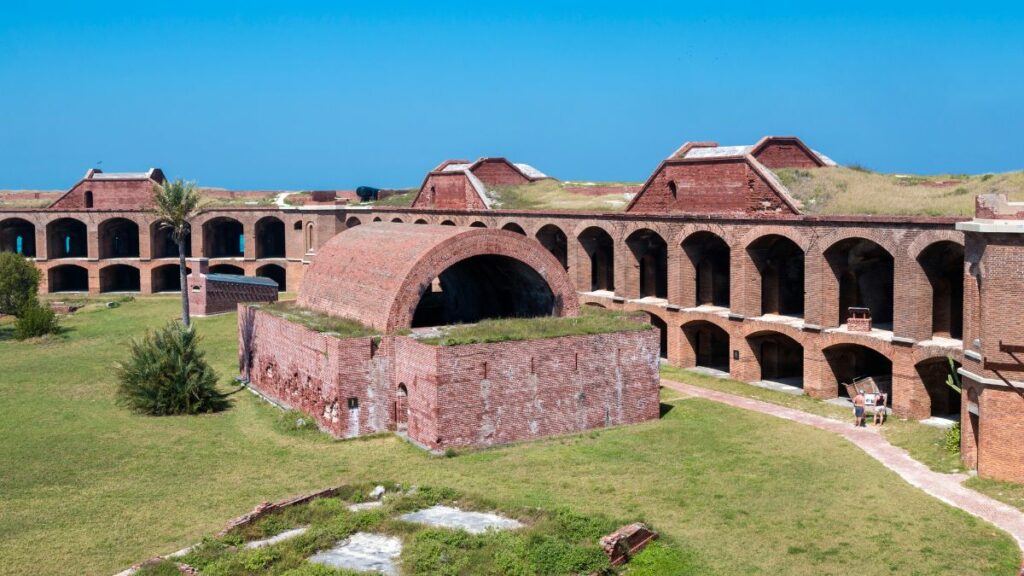
Fort Jefferson, situated on Garden Key in the Dry Tortugas National Park, is an architectural marvel and a monument of historical significance. Its remote location, approximately 70 miles west of Key West in the Gulf of Mexico, adds an element of intrigue to its grandeur.
Constructed in the mid-19th century, this enormous coastal fortification comprises over 16 million bricks, making it one of the largest brick structures in the Americas. The imposing hexagonal fortress was designed with three tiers of guns and was intended to control navigation in the Gulf of Mexico and protect the United States’ southern coastline.
Despite its formidable architecture and strategic location, Fort Jefferson never saw combat. Instead, it served as a crucial military outpost during the Civil War, providing a base for Union warships enforcing the blockade on Southern shipping. The fort’s isolation also made it a suitable location for a military prison, housing deserters and other military convicts.
Its most famous inmate was Dr. Samuel Mudd, convicted of aiding and conspiring with John Wilkes Booth, Abraham Lincoln’s assassin. Sentenced to life imprisonment, Mudd served his time in Fort Jefferson until President Andrew Johnson pardoned him.
Adding a tragic chapter to its history, Fort Jefferson experienced a deadly outbreak of yellow fever in the late 19th century. The epidemic claimed several lives, including the fort’s physician. Despite being a prisoner, Dr. Mudd stepped in to provide medical aid during this crisis, a role that significantly earned him a presidential pardon.
Fort Jefferson Today
Today, despite being unfinished and suffering damage over the years from hurricanes and erosion, Fort Jefferson stands as a testament to human ambition and endurance. The fort, combined with the surrounding clear blue waters, vibrant coral reefs, and rich marine life, makes Dry Tortugas National Park a unique destination.
Visitors can explore the fort’s massive walls, peek into the lives of soldiers who once lived there, or walk along the moat wall for panoramic ocean views. Fort Jefferson is not just a historical monument but also a symbol of resilience, a site of human tragedy, and an example of architectural grandeur, all located in the heart of one of America’s most stunning natural landscapes.
3. Fort Clinch

Fort Clinch is a historic site on the northern end of Amelia Island, a barrier island off Florida’s northeast coast. Surrounded by the natural beauty of a state park, this fort offers stunning views of the Atlantic Ocean, and its well-preserved structures provide a vivid window into the past, particularly the Civil War era.
The fort, named after General Duncan Lamont Clinch, a prominent figure in the Second Seminole War, began its construction in 1847. Fort Clinch was designed to protect the mouth of the St. Marys River and the deep-water port of Fernandina, part of the third system of fortifications, a defensive strategy developed by the United States after the War of 1812.
The fort’s strategic importance ensured that Union and Confederate troops sought to control it during the Civil War. At the war’s onset in 1861, Confederate forces seized control of the incomplete fort and held it for over a year.
However, they abandoned it when the Union gunboats posed a significant threat. The Union forces then moved in without a fight, completing the fort and using it as a base of operations in the area for the rest of the war.
After The Civil War
Beyond the Civil War, Fort Clinch also saw service during the Spanish-American War, serving as part of the coastal defense system but never saw any combat action.
One of the key attractions of Fort Clinch State Park today is its living history program. During these events, volunteers reenact life at the fort during the Civil War, wearing period uniforms and performing historical demonstrations. Visitors can step back in time, witnessing soldier life, medical practices, and infantry demonstrations, all set within the fort’s well-preserved walls.
The surrounding state park also adds to the allure of Fort Clinch. The park has over 1,400 acres and features diverse ecosystems, including coastal dunes, overwash plains, and maritime hammocks. It’s a haven for outdoor activities such as fishing, bird watching, hiking, and beachcombing.
4. Fort Zachary Taylor
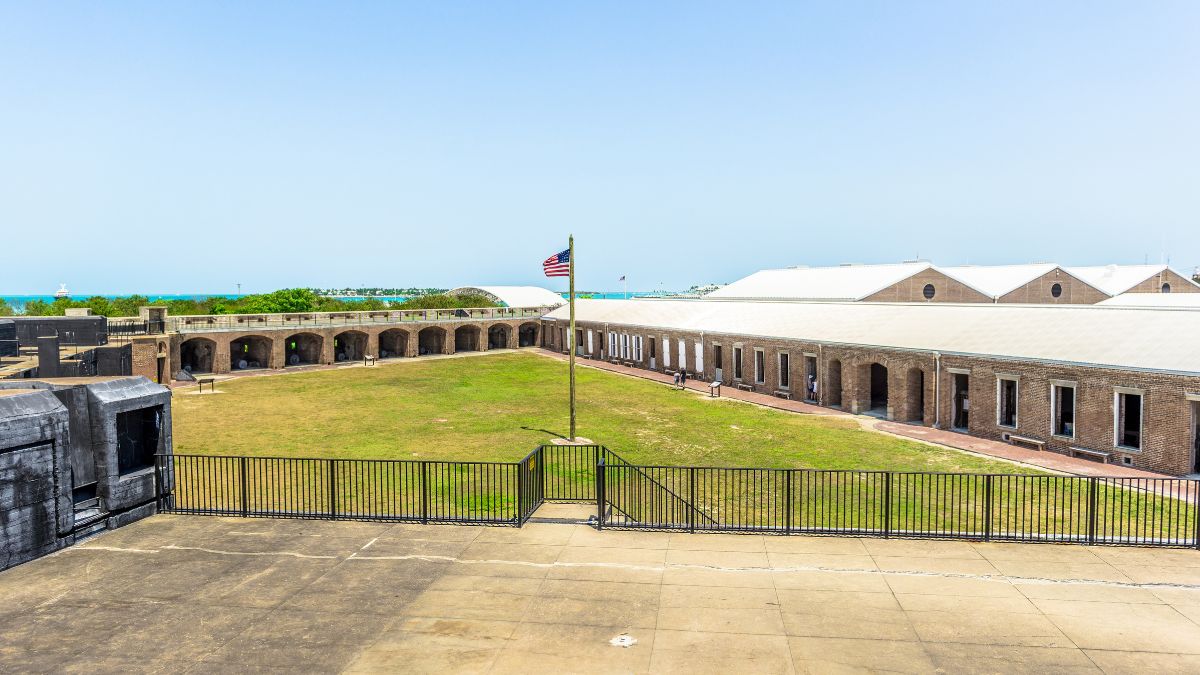
Fort Zachary Taylor, situated at the southernmost tip of the Florida Keys in Key West, is a crucial part of the region’s rich historical tapestry. Built-in the mid-19th century as part of the country’s third system of fortifications, its strategic position at the Gulf of Mexico’s entrance made it a valuable military asset.
Fort Zachary Taylor was important during the Civil War due to its strategic location. While Florida seceded with the Confederacy, the fort remained under Union control throughout the conflict, serving as an essential outpost for the Union Navy’s East Gulf Coast Blockade Squadron.
The fort’s role in enforcing the Union’s naval blockade was critical in preventing Confederate ships from carrying cotton to their European allies, significantly hampering the Confederate war effort.
The fort’s relevance continued into the Spanish-American War at the end of the 19th century. As tensions between Spain and the United States escalated, Fort Zachary Taylor was updated with new, powerful guns and minefield defenses to guard against potential Spanish naval attacks. While the fort didn’t see combat during the conflict, its presence served as a deterrent and a base for U.S. naval operations in the Caribbean.
Fort Zachary Taylor Today
Today, Fort Zachary Taylor is part of the Gulf Islands National Seashore and is recognized as a National Historic Landmark. Its well-preserved fortifications offer visitors a glimpse into the past, while its location provides breathtaking ocean views. The fort is renowned for having the largest collection of Civil War cannons in the United States, many of which were discovered submerged in concrete during a restoration project in the 1960s.
In addition to its historical attractions, Fort Zachary Taylor State Park is a paradise for nature and beach lovers. The park boasts a beautiful beach—often considered one of Key West’s best—for swimming and snorkeling, as well as opportunities for fishing and bird-watching.
Fort Zachary Taylor has witnessed critical chapters in American history from the Civil War to the Spanish-American War. Today, it is a testament to those times, combining historical significance with natural beauty.
Whether visitors are history buffs or nature enthusiasts, Fort Zachary Taylor Historic State Park offers a unique experience to explore the past and appreciate the scenic allure of the Florida Keys.
5. Fort Pickens
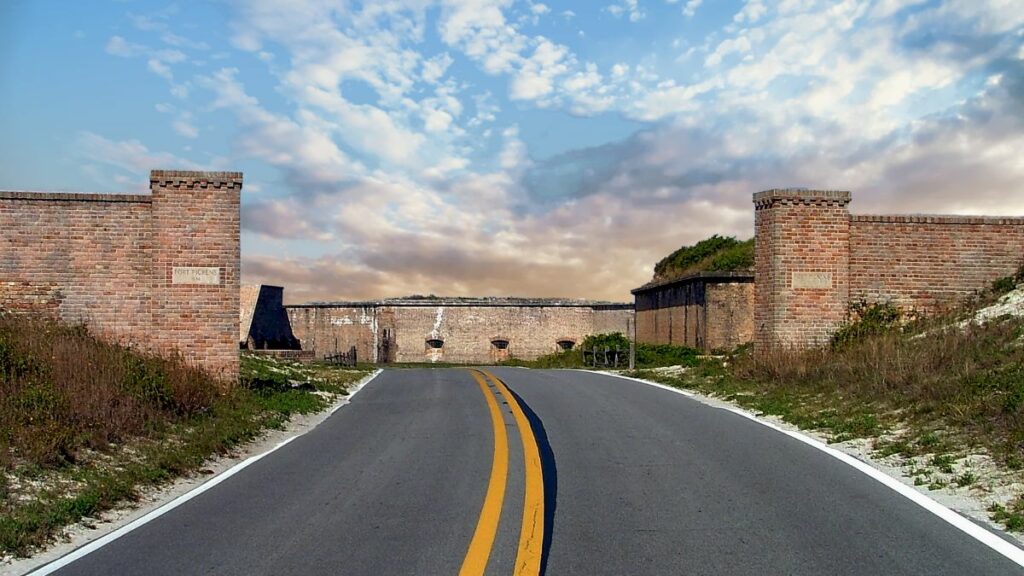
Fort Pickens, located on the western tip of Santa Rosa Island in Pensacola Bay, is a fascinating historical landmark in Florida. It was constructed during the early 19th century as part of the United States effort to fortify its coastline following the War of 1812.
Named after Revolutionary War hero General Andrew Pickens, Fort Pickens’ primary purpose was to defend the Pensacola Bay area and its strategically important navy yard. Built with over 21 million bricks, the fort’s distinctive pentagonal shape and sturdy construction were designed to withstand a potential sea attack.
Fort Pickens has a notable history, having survived several wars and played critical roles in different conflicts. It was one of four forts in the South that remained under Union control throughout the Civil War, despite Florida being part of the Confederacy.
The fort was critical in the Union’s strategy to enforce a naval blockade of Southern ports. The first shots fired by the Union in Pensacola during the Civil War happened here, marking the start of the Union’s aggressive stance in Florida.
In 1886, the fort served as a prison for the famous Apache leader Geronimo and several of his warriors. They were kept there as prisoners of war, and their presence turned the fort into a popular tourist attraction, with people coming from all around to see the Apache leader.
The fort’s military importance extended into the 20th century, as it was utilized during both World Wars. However, after World War II, the fort was decommissioned and eventually transferred to the National Park Service.
Fort Pickens Today
Today, managed by the National Park Service, Fort Pickens is part of the Gulf Islands National Seashore and an engaging destination for history enthusiasts and nature lovers.
Visitors can explore the well-preserved fort, walk through its extensive tunnel system, and see historical weaponry displays. The surrounding area also offers beautiful beaches, camping facilities, bird-watching opportunities, and stunning views over the Gulf of Mexico and Pensacola Bay.
Fort Pickens is a testament to the changing times and evolving defense strategies over the centuries. It embodies the region’s rich history while offering a serene natural getaway, making it a must-visit destination in the Florida Panhandle.
Experiencing the Forts: Tips and Recommendations
When exploring Florida’s historic forts, it’s crucial to consider the state’s typically humid and warm weather. The subtropical climate can be intense, especially during the summer months. Visiting early in the morning or late in the afternoon can provide more pleasant conditions for exploration. It’s also important to stay hydrated and protect yourself from the sun.
Many of these historic forts are situated within state parks or national seashores, like Fort Clinch State Park and Fort Zachary Taylor Historic State Park, and come equipped with amenities to ensure your visit is comfortable. These facilities typically include restrooms, picnic areas, and visitor centers. The parks often offer recreational activities such as hiking, swimming, fishing, and wildlife spotting, making them perfect destinations for an enriching and diverse outdoor experience.
Guided tours are a fantastic way to delve deeper into the history of these forts. Knowledgeable guides can offer insights into the architectural details, strategic purposes, and historical events associated with these sites that you may not glean from a self-guided tour.
If you’re visiting Fort Jefferson, also explore the West Martello Towers. These towers, now home to the Key West Garden Club, are a part of the island’s fortifications system, built during the Civil War. The Towers also offer beautiful gardens and fantastic ocean views, making it a worthwhile stop.
After immersing yourself in the history of Fort Clinch, don’t miss the chance to enjoy the charms of Fernandina Beach. This historic town, known as the “Isle of 8 Flags”, offers a picturesque downtown area filled with shops, restaurants, and Victorian-era architecture. The beach is a haven for relaxation and offers excellent shelling and shark-tooth hunting opportunities.
Lastly, remember to respect the historical integrity of these sites and the natural beauty of their surroundings. These forts are more than just old structures; they’re pieces of a puzzle that make up the complex and fascinating story of Florida’s past. By visiting them, you’re stepping into history and gaining a deeper appreciation for the events that have shaped this region and, in broader terms, the United States.
Conclusion – Historic Forts in Florida
Exploring historic forts in Florida offers a unique journey, from the state’s early days as a Spanish stronghold to its role in significant conflicts. As you walk through the corridors of these forts, you don’t just see a slice of Florida history – you feel it. So why not pack your bags, put on your explorer’s hat, and step into the fascinating world of Florida’s historic forts?
Have you visited these historic landmarks in Florida? Do you have your own stories to share or plans to visit? Drop a comment below and share your experiences or expectations! And don’t forget to spread the word about the wonders of Florida tourism by sharing this post on social media. Happy exploring!

Cory is a website owner and content creator who enjoys fishing, history, coin collecting, and sports, among other hobbies. He is a husband and father of four.
Romans 15:4 For whatever was written in former days was written for our instruction, that through endurance and through the encouragement of the Scriptures we might have hope.

